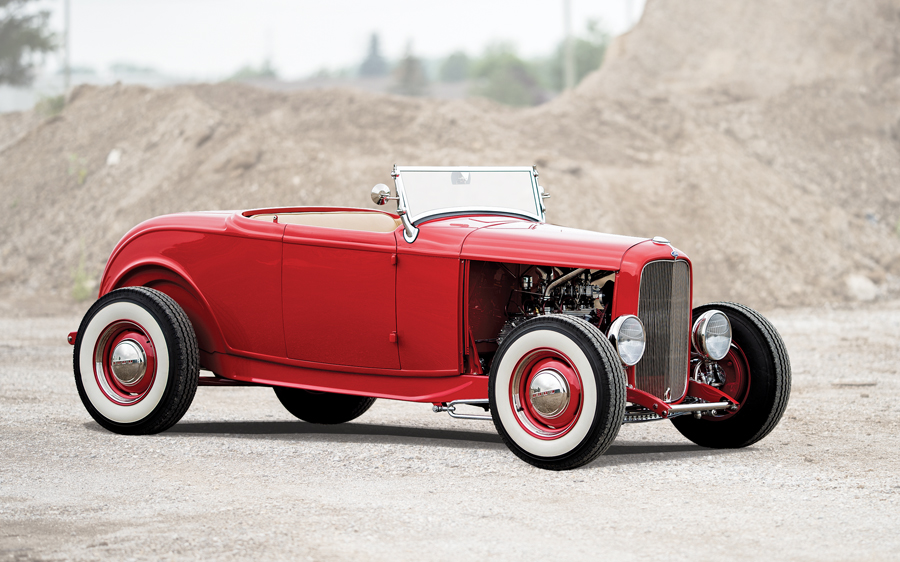- Offered from the collection of Jack Dunning
- Professional build by Glenn and Randy Hatcher
- Brookville steel body and chassis
- 1939 Ford flathead V8 engine and driveline
- This car, Lot 431, sold for $65,450, including buyer’s premium, at RM Auctions’ sale in
- Hershey, PA, on October 11, 2019.
SCM Analysis
Detailing
| Vehicle: | 1932 Ford Roadster |
| Years Produced: | 1932 |
| Number Produced: | 6,893 DeLuxe Roadsters; 520 Standard Roadsters |
| Original List Price: | Deluxe Roadster, $500; Standard Roadster, $460 |
| SCM Valuation: | $38,500 |
| Tune Up Cost: | $250 (estimate) |
| Chassis Number Location: | Stamped on frame rail in front of the firewall on the driver’s side |
| Alternatives: | Other ’50s-era hot rod street roadsters |
| Investment Grade: | C |
Hot-rodders covet 1932 Fords, especially roadsters.
From the outset, the ’32 came equipped with the first edition of Ford’s doughty flathead V8, iconic styling and a paucity of weight with its fenders removed. So it didn’t take long before hot-rodders began buying up every “Deuce” roadster available.
In the 1970s, a shortage of usable roadsters led to the creation of fiberglass replica bodies, first by Dee Wescott, then others.
Reality check
But serious rodders wanted real “Henry” steel. The trouble is, most of those bodies required extensive restoration work, and they had become very expensive even in rough condition. So Ray Gollahon and his son Kenny, in Brookville, OH, bought the requisite vintage stamping machines, tooled up, and began turning out exact replica all-steel ’32 roadsters.
Brookville Roadster’s products are highly respected, and the Ohio factory will sell you a roller — a properly jigged Deuce roadster body on reproduction frame rails, with axles, brakes and wheels — for about $60,000 with all the options.
In this case, the buyer got a running car for the price of a bare-steel “roller.” That’s a good deal, but bear with me for a minute.
The seller, Jack Dunning, probably paid a lot more than $65k for the car you see here. He commissioned builders Glenn and Randy Hatcher to do the assembly work.
A ’39 Ford donated its engine, hydraulic drum brakes, a sturdy 3-speed floor-shift transmission and a rugged Ford banjo rear end. The auction description is short on detail, but there’s a proper ’32 Ford 18-prefix VIN number.
The engine appears to be the stock ’39 Ford 24-stud flathead, slightly modified with an Offenhauser triple intake manifold, topped with three Stromberg 97s. There’s a set of finned aluminum Offy high-compression heads as well. The two end carbs have blocking plates, which makes sense because triple 97s would overwhelm a stock ’39 Ford 221-ci V8.
Time for a few changes
The problem is this is a “belly-button” car. It looks like countless others. There’s no individual statement, and what’s even worse for a hot rod, it’s seriously underpowered. But it’s a good start, and if you’re the buyer, you’ve saved some money over building it from scratch. But another $20k to $25k would make it a much better car.
Here’s what I’d do.
After checking the engine block for cracks, I’d bore it out, install lightweight 3 5/16ths forged pistons and a four-inch Scat stroker crank, fit oversized 1.75-inch valves, port and relieve the block for better breathing, and add a high-performance ignition.
There are many great camshafts available for flatheads. I like the Isky 400 Jr., and I’d go with adjustable tappets and Lincoln-Zephyr-style valve springs.
That work would cost about $8k to $10k and boost output to 175 to 200 hp. Alternatively, for much less money, you could buy an OHV later-model Chevy or Ford crate motor, a set of engine mounts and an adaptor, and you’d have an easy, bolt-in, 300 hp. Fit old-style valve covers and carbs and you’d be in business.
We’re not done yet
For a more authentic look, Rootlieb sells a hood for this car in steel; I’d get the later-style 25-louver job — it looks great and helps a flathead breathe better. The builders used big Ford Commercial headlamps. I’d fit smaller, more stylish Guide 682-Cs, available in repop form, with built-in directional lights. That low-mounted license plate belongs on the flat valence between the existing ’39 Ford teardrops, and rod shops offer vintage-style license-plate lights. The tailpipes should be rerouted to the frame rails.
I’d lose the whitewalls and trim rings, and substitute Coker 4.50–4.75:16 and 7:50:16 blackwall Firestone bias-plies for a more righteous tilt. For an even lower look, flatten a couple of springs fore and aft. To give this roadster some real character, I’d rub through the paint in several places with Scotchbrite pads for a cool patina.
That dropped and drilled front axle is fine, but original Ford hydraulics aren’t up to today’s stopping standards. So-Cal Speed Shop offers a set of reproduction Buick finned drums packed with contemporary disc brakes. We’re going after a late-’50s look here, so they’ll work. Keep the rear drums, but be sure to install a proportioning valve. If you’ve got money left, replace the modern S-W gauges with vintage units from a swapmeet. Hot rods are all about individuality, so you can juggle hubcap choices, add an old steering wheel, and do a few more things to personalize your ride.
Bottom line: At $65k, this Highboy was a good deal and a great starting point. Spend a little more and you’ll have a much more credible hot rod — and something that can bring even more at sale time.
(Introductory description courtesy of RM Auctions.)
